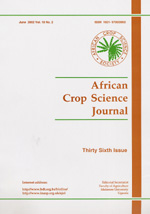
|
African Crop Science Journal
African Crop Science Society
ISSN: 1021-9730
EISSN: 1021-9730
Vol. 28, No. 4, 2020, pp. 595-616
|
 Bioline Code: cs20065
Bioline Code: cs20065
Full paper language: English
Document type: Research Article
Document available free of charge
|
|
|
African Crop Science Journal, Vol. 28, No. 4, 2020, pp. 595-616
| fr |
Osaliya, R.; Wasonga, O.V.; Majaliwa Mwanjalolo, J-G.; MacOpiyo, L.; Kironchi, G. & Adipala, E.
Résumé
Les bassins versants semi-arides de Lokere et de Lokok dans le nord-est de l’Ouganda connaissent un changement d’utilisation des terres et de couverture terrestre (UTCT) motivé par des politiques et des actions visant la sédentarisation des pasteurs. Si ces efforts présentent une trajectoire d’un paysage dominé par l’agriculture, l’élevage ou le pâturage persiste. L’objectif de cette étude était de projeter une UTCT à moyen et long terme pour les bassins versants de Lokere et Lokok à Karamoja, en Ouganda. Nous avons appliqué un réseau neuronal multi-perception automatique, construit sur la méthode de modélisation de chaîne de Markov, ainsi que des stratégies d’évaluation multicritères; tous intégrés dans le modèle IDRISI Land Change Modeler (LCM) pour projeter le UTCT des bassins versants jusqu’en 2030 et 2050. Le modèle a été formé à l’aide de 1994 et 2003 UTCT, et validé avec UTCT de 2013. Résultats de trois scénarios de politique modélisés; business as usual (BAU), pro-bétail et pro-agriculture; a montré que l’agriculture à petite échelle (SSF) augmenterait dans tous les scénarios, même si les politiques changeaient pour promouvoir l’élevage pour les années 2030 et 2050. Des politiques favorables à l’agriculture entraîneraient, en 2030 et 2050, une réduction des prairies à mesure que les champs de culture augmentent; doubler sa superficie de 2003 d’ici 2050. Les résultats de cette étude facilitent l’évaluation des impacts potentiels de UTCT future et l’évaluation des politiques dans les bassins versants.
Mots Clés
modeleur de changement foncier; évaluation de politique foncière; pastoralisme; sédentarisation
|
| |
| en |
Predicted land use and land cover outlook for semi-arid Lokere and Lokok catchments in Karamoja region, Uganda
Osaliya, R.; Wasonga, O.V.; Majaliwa Mwanjalolo, J-G.; MacOpiyo, L.; Kironchi, G. & Adipala, E.
Abstract
The semi-arid Lokere and Lokok catchments in northeastern Uganda are experiencing land use and land cover (LULC) change driven by policies and actions aimed at pastoralist sedentarisation. While these efforts present a trajectory of a landscape dominated by farming, livestock herding or grazing persists. The objective of this study was to project medium, and long-term LULC for Lokere and Lokok catchments in Karamoja, Uganda. We applied automatic multi-perceptron neural network, built on Markov chain modeling method, along with multi-criteria evaluation strategies; all embedded in the IDRISI Land Change Modeler (LCM) to project the catchments’ LULC to the year 2030 and 2050. The model was trained using 1994 and 2003 LULC, and validated with 2013 LULC. Results of three modelled policy scenarios; business as usual (BAU), pro-livestock and pro-farming; to the years 2030 and 2050 showed that small scale farming (SSF) would increase in all scenarios, even if policy shifts to promote livestock rearing. Pro-farming policies would, in both 2030 and 2050, result in reduction of grassland as SSF increases; doubling the 2003 land area by 2050. The results of this study facilitate assessment of potential impacts of the future LULC and policy evaluation in the catchments.
Keywords
Land Change Modeler; land policy evaluation; pastoralism; sedentarisation
|
| |
© Copyright 2020 - African Crop Science Society
|
|
